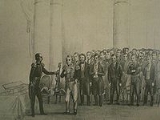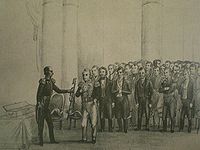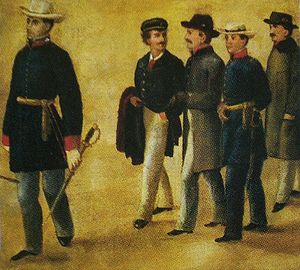
Carlos Soublette
Encyclopedia
Carlos Soublette was President of Venezuela 1837-1839 and 1843–1847, and a hero of the Venezuelan War of Independence
.
Carlos Valentín José de la Soledad Antonio del Sacramento Soublette was born in La Guaira
on 15 December 1789. He was the son of Antonio Soublette y Piar, a native of Tenerife
, and Teresa Jeréz de Aristiguieta. On 18 May 1810 entered at the army in the squadron of Caracas, being soon promoted like Lieutenant, commanded by Francisco de Miranda
at the campaign destinated to dominate an insurrection in Valencia, from this was promoted as captain.
On 12 February 1812 he married Ollala Buroz. Also during that year, as lieutenant colonel he commanded a squadron of the republican army against the royalists forces led by Juan Domingo de Monteverde
. At the end of the First Republic, he was reduced to imprisonment at the San Felipe castle of Puerto Cabello
. Released in 1813, he enlisted the Liberator Army, which concluded the Admirable Campaign
. Under the command of José Félix Ribas
he fought in the battle of Vigirima, as well as in La Victoria in 1814. Participates at the emigration of the Republican Army to the Venezuelan east (July, 1814). On 17 August, intervened at the battle of Aragua de Barcelona. At the end of the Second Republic, he emigrated to New Grenada (Colombia
) along with Simón Bolívar
, participating at military actions in Santa Fe de Bogotá (December, 1814), Magdalena and Cartagena
(1815).

 On May, 1815, he emigrated to the West Indies, being part in Haiti
On May, 1815, he emigrated to the West Indies, being part in Haiti
of the forces that in 1816 made an expedition to the Venezuelan coasts (Expedición de los Cayos). Subsequently, on 1 June during an action in Carúpano
, under the direction of Manuel Piar
, he acted against the left flank of the city. He was appointed Governor of the Central headquarters on 23 June and received the appointment of interim chief of General Staff, replacing Colonel Henri Ducoudray-Holstein. On 31 December 1816 he joined the forces of Simón Bolívar
in Barcelona. On 2 January 1817 Bolivar named him as member of the Order of Liberators of Venezuela. On 9 January, he fought in Clarines
, being defeated and injured. On March 1817, he marched with Bolívar to Guayana
, being part of the operations for the liberation of this province. At that time he was sub-chief of the General Staff, serving on 3 October, as prosecutor at the trial to Manuel Piar. In the Battle of Boyacá
in 1819, he commanded one of the platoons of the victorious Republican Army. On 1 May 1820, Soublette was promoted by Bolívar as Divisional General. The same day, by executive decree, he was appointed Interim Vice President of Venezuela.
In 1822 he was designated as Intendent of the Department of Venezuela and was responsible for directing the war at the province of Coro, where royalists forces operated under the command of Marshal Francisco Tomás Morales. On 20 July 1822, he destroyed in Mitare a big part of the Royalist cavalry. On 7 September he was defeated by Morales at the battle of Dabajuro. On 3 March 1825, as a result of the resignation of General Pedro Briceno Mendez, Soublette was appointed Secretary of War and Navy of the Republic of Colombia. In January 1830, at the time of separation of Venezuela
from Greater Colombia, he was designated Secretary of War and Navy of Venezuela. In 1834 was postulated candidate for the Presidency, being his contenders, Bartolomé Salom, Santiago Mariño
, Diego Bautista Urbaneja and José María Vargas
. The elections were won by Vargas. In 1835 and 1836 served as Minister Plenipotentiary and Envoy Extraordinary to England and Spain, with the important mission of the recognition of the independence of Venezuela.
In 1837 he was elected Vice-President of Venezuela, assuming the Presidency after the resignation of Vargas, being in charge until 28 January 1839. On 26 January 1843 he assumed the presidency again, after winning the elections. On 20 January 1847, he left office, assuming vice president Diego Bautista Urbaneja until 1 March 1847. In 1848 Soublette retired to his ranch in Chaguaramas . On 24 January 1848, when the attacks against Congress from José Tadeo Monagas
occurs, Soublette joined José Antonio Páez as head of General Staff against Monagas government, being defeated at the battle of Araguatos, emigrating to New Grenada and settled in Santa Marta. In 1858, he returned to Venezuela, accepting the invitation of President Julián Castro
. In 1860 he was Senator for the province of Caracas and Secretary of State at the government of Pedro Gual
. After the triumph of the Federation, he retired from public life only to return briefly before his death, during the government of the Blue Revolution (Revolución Azul) led by José Ruperto Monagas
between 1869 to 1870.
Carlos Soublette died in Caracas
, on 11 February 1870 and was buried on 14 February at the Hijos de Dios cemetery. On 7 February 1970 was transferred to the National Pantheon of Venezuela.
Venezuelan War of Independence
-The First Republic:Criollos resented the mercantilist policies of Spain. Trade was only allowed in Pacific ports which was a terrible burden for Argentina, Paraguay and the Caribbean colonies. This is significant as Cuba and Puerto Rico were forced to allow free trade in 1763 by Britain and...
.
Carlos Valentín José de la Soledad Antonio del Sacramento Soublette was born in La Guaira
La Guaira
La Guaira is the capital city of the Venezuelan state of Vargas and the country's chief port. It was founded in 1577 as an outlet for Caracas, to the southeast. The town and the port were badly damaged during the December 1999 floods and mudslides that affected much of the region...
on 15 December 1789. He was the son of Antonio Soublette y Piar, a native of Tenerife
Tenerife
Tenerife is the largest and most populous island of the seven Canary Islands, it is also the most populated island of Spain, with a land area of 2,034.38 km² and 906,854 inhabitants, 43% of the total population of the Canary Islands. About five million tourists visit Tenerife each year, the...
, and Teresa Jeréz de Aristiguieta. On 18 May 1810 entered at the army in the squadron of Caracas, being soon promoted like Lieutenant, commanded by Francisco de Miranda
Francisco de Miranda
Sebastián Francisco de Miranda Ravelo y Rodríguez de Espinoza , commonly known as Francisco de Miranda , was a Venezuelan revolutionary...
at the campaign destinated to dominate an insurrection in Valencia, from this was promoted as captain.
On 12 February 1812 he married Ollala Buroz. Also during that year, as lieutenant colonel he commanded a squadron of the republican army against the royalists forces led by Juan Domingo de Monteverde
Juan Domingo de Monteverde
Juan Domingo de Monteverde y Rivas , commonly known as Domingo de Monteverde, was a Spanish soldier, governor and Captain General of Venezuela from June 1812 to 8 August 1813. Monteverde was the leader of Spanish forces in the Venezuelan War of Independence from 1812 to 1813...
. At the end of the First Republic, he was reduced to imprisonment at the San Felipe castle of Puerto Cabello
Puerto Cabello
Puerto Cabello is a city on the north coast of Venezuela. It is located in Carabobo State about 75 km west of Caracas. As of 2001, the city has a population of around 154,000 people. The city is the home to the largest port in the country and is thus a vital cog in the country's vast oil...
. Released in 1813, he enlisted the Liberator Army, which concluded the Admirable Campaign
Admirable Campaign
The Admirable Campaign was a military action led by Simón Bolívar in which the provinces of Mérida, Barinas, Trujillo and Caracas were conquered by the independentists...
. Under the command of José Félix Ribas
José Félix Ribas
José Félix Ribas , was a Venezuelan independence leader and hero of the Venezuelan War of Independence.-Early life:Ribas was the last of eleven sons, born to a prominent Caracas family. In his early years, he received a quality education and attended the city's seminary. After finishing his...
he fought in the battle of Vigirima, as well as in La Victoria in 1814. Participates at the emigration of the Republican Army to the Venezuelan east (July, 1814). On 17 August, intervened at the battle of Aragua de Barcelona. At the end of the Second Republic, he emigrated to New Grenada (Colombia
Colombia
Colombia, officially the Republic of Colombia , is a unitary constitutional republic comprising thirty-two departments. The country is located in northwestern South America, bordered to the east by Venezuela and Brazil; to the south by Ecuador and Peru; to the north by the Caribbean Sea; to the...
) along with Simón Bolívar
Simón Bolívar
Simón José Antonio de la Santísima Trinidad Bolívar y Palacios Ponte y Yeiter, commonly known as Simón Bolívar was a Venezuelan military and political leader...
, participating at military actions in Santa Fe de Bogotá (December, 1814), Magdalena and Cartagena
Cartagena, Colombia
Cartagena de Indias , is a large Caribbean beach resort city on the northern coast of Colombia in the Caribbean Coast Region and capital of Bolívar Department...
(1815).


Haiti
Haiti , officially the Republic of Haiti , is a Caribbean country. It occupies the western, smaller portion of the island of Hispaniola, in the Greater Antillean archipelago, which it shares with the Dominican Republic. Ayiti was the indigenous Taíno or Amerindian name for the island...
of the forces that in 1816 made an expedition to the Venezuelan coasts (Expedición de los Cayos). Subsequently, on 1 June during an action in Carúpano
Carúpano
Carúpano is a city in the eastern Venezuelan state of Sucre. It is located on the Venezuelan Caribbean coast at the opening of two valleys, some 120 km east of the capital of Sucre, Cumaná...
, under the direction of Manuel Piar
Manuel Piar
Manuel Carlos Piar was General-in-Chief of the army fighting Spain during the Venezuelan War of Independence.-Heritage and early life:...
, he acted against the left flank of the city. He was appointed Governor of the Central headquarters on 23 June and received the appointment of interim chief of General Staff, replacing Colonel Henri Ducoudray-Holstein. On 31 December 1816 he joined the forces of Simón Bolívar
Simón Bolívar
Simón José Antonio de la Santísima Trinidad Bolívar y Palacios Ponte y Yeiter, commonly known as Simón Bolívar was a Venezuelan military and political leader...
in Barcelona. On 2 January 1817 Bolivar named him as member of the Order of Liberators of Venezuela. On 9 January, he fought in Clarines
Clarines
Clarines is a town in Venezuela's Anzoátegui State, located from Puerto La Cruz, and . from Puerto Piritu. It serves as the administrative centre for the surrounding Manuel Ezequiel Bruzual Municipality. The estimated population is 15,000 .-History:...
, being defeated and injured. On March 1817, he marched with Bolívar to Guayana
Bolívar (state)
Bolívar State , is one of the 23 states into which Venezuela is divided. The state capital city is Ciudad Bolívar. Bolívar State covers a total surface area of 238,000 km² and in June 30, 2010 had an estimated population of 1,620,359....
, being part of the operations for the liberation of this province. At that time he was sub-chief of the General Staff, serving on 3 October, as prosecutor at the trial to Manuel Piar. In the Battle of Boyacá
Battle of Boyacá
The Battle of Boyacá in Colombia, then known as New Granada, was the battle in which Colombia acquired its definitive independence from Spanish Monarchy, although fighting with royalist forces would continue for years....
in 1819, he commanded one of the platoons of the victorious Republican Army. On 1 May 1820, Soublette was promoted by Bolívar as Divisional General. The same day, by executive decree, he was appointed Interim Vice President of Venezuela.
In 1822 he was designated as Intendent of the Department of Venezuela and was responsible for directing the war at the province of Coro, where royalists forces operated under the command of Marshal Francisco Tomás Morales. On 20 July 1822, he destroyed in Mitare a big part of the Royalist cavalry. On 7 September he was defeated by Morales at the battle of Dabajuro. On 3 March 1825, as a result of the resignation of General Pedro Briceno Mendez, Soublette was appointed Secretary of War and Navy of the Republic of Colombia. In January 1830, at the time of separation of Venezuela
Venezuela
Venezuela , officially called the Bolivarian Republic of Venezuela , is a tropical country on the northern coast of South America. It borders Colombia to the west, Guyana to the east, and Brazil to the south...
from Greater Colombia, he was designated Secretary of War and Navy of Venezuela. In 1834 was postulated candidate for the Presidency, being his contenders, Bartolomé Salom, Santiago Mariño
Santiago Mariño
Santiago Mariño , was a nineteenth-century Venezuelan revolutionary leader and hero in the Venezuelan War of Independence...
, Diego Bautista Urbaneja and José María Vargas
José María Vargas
José María Vargas was the 4th President of Venezuela from 1835–1836.-Life and career:...
. The elections were won by Vargas. In 1835 and 1836 served as Minister Plenipotentiary and Envoy Extraordinary to England and Spain, with the important mission of the recognition of the independence of Venezuela.
In 1837 he was elected Vice-President of Venezuela, assuming the Presidency after the resignation of Vargas, being in charge until 28 January 1839. On 26 January 1843 he assumed the presidency again, after winning the elections. On 20 January 1847, he left office, assuming vice president Diego Bautista Urbaneja until 1 March 1847. In 1848 Soublette retired to his ranch in Chaguaramas . On 24 January 1848, when the attacks against Congress from José Tadeo Monagas
José Tadeo Monagas
José Tadeo Monagas Burgos was President of Venezuela 1847-1851 and 1855–1858, and a hero of the Venezuelan War of Independence...
occurs, Soublette joined José Antonio Páez as head of General Staff against Monagas government, being defeated at the battle of Araguatos, emigrating to New Grenada and settled in Santa Marta. In 1858, he returned to Venezuela, accepting the invitation of President Julián Castro
Julián Castro
- See also :*Venezuela*Presidents of Venezuela...
. In 1860 he was Senator for the province of Caracas and Secretary of State at the government of Pedro Gual
Pedro Gual Escandon
Pedro José Ramón Gual Escandón , was a Venezuelan lawyer, politician, journalist and diplomat...
. After the triumph of the Federation, he retired from public life only to return briefly before his death, during the government of the Blue Revolution (Revolución Azul) led by José Ruperto Monagas
José Ruperto Monagas
José Ruperto Monagas was President of Venezuela between 1869-1870. Also, he was a son of José Tadeo Monagas.-Biography:...
between 1869 to 1870.
Carlos Soublette died in Caracas
Caracas
Caracas , officially Santiago de León de Caracas, is the capital and largest city of Venezuela; natives or residents are known as Caraquenians in English . It is located in the northern part of the country, following the contours of the narrow Caracas Valley on the Venezuelan coastal mountain range...
, on 11 February 1870 and was buried on 14 February at the Hijos de Dios cemetery. On 7 February 1970 was transferred to the National Pantheon of Venezuela.
See also
- VenezuelaVenezuelaVenezuela , officially called the Bolivarian Republic of Venezuela , is a tropical country on the northern coast of South America. It borders Colombia to the west, Guyana to the east, and Brazil to the south...
- Presidents of Venezuela

